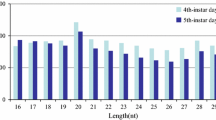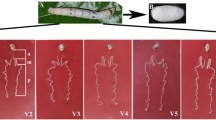Abstract
MicroRNAs (miRNAs) are endogenous single-stranded RNAs of 18–22 nt in length, which can regulate the complementary mRNAs at the post-transcriptional level by cleavage or repression of translation of the target mRNAs. Studies have shown that the majority of animal miRNAs are transcribed from independent transcription units, and some are transcribed together with their host genes. However, the nature of the primary transcript of intergenic miRNAs remains unknown. Silkworm (Bombyx mori) miRNAs are representative of those of the Lepidoptera insects and many of them are conserved in Caenorhabditis elegans and other animal species. To date, little is known about the transcriptional regulation of silkworm miRNA genes. We performed the genomic analysis on the silkworm miRNA transcripts around the promoter region including the transcription start site (TSS) and the TATA-box, and on the organization of the miRNA cluster. In 73 pre-miRNAs from the silkworm 131 promoters were detected via a bioinformatics approach. Among them the portion of non-conserved promoters is greater than that of the conserved ones. The genomic organization of pre-miRNAs of the silkworm was globally analyzed and it was determined that 11 of them were organized into five clusters. Sequence alignment showed that paralogs existed for some of the miRNAs in the cluster. These results may increase the understanding of the specific sequences upstream of the pre-miRNAs and of the functional implications of miRNA clusters in the silkworm.
Similar content being viewed by others
References
Aravin A.A., Lagos-Quintana M., Yalcin A., Zavolan M., Marks D., Snyder B., Gaasterland T., Meyer J., Tuschl T. 2003. The small RNA profile during Drosophila melanogaster development. Dev. Cell. 5, 337–350.
Bentwich I., Avniel A., Karov Y., Aharonov R., Gilad S., Barad O., Barzilai A., Einat P., Einav U., Meiri E., Sharon E., Spector Y., Bentwich Z. 2005. Identification of hundreds of conserved and nonconserved human microRNAs. Nature Genet. 37, 766–770.
Wang X.J., Reyes J.L., Chua N.H., Gaasterland T. 2004. Prediction and identification of Arabidopsis thaliana microRNAs and their mRNA targets. Genome Biol. 5, R65.
Zhang B., Wang Q., Pan X. 2007. MicroRNAs and their regulatory roles in animals and plants. J. Cell. Physiol. 210, 279–289.
Lee Y., Jeon K., Lee J.T., Kim S., Kim V.N. 2002. MicroRNA maturation: Stepwise processing and subcellular localization. EMBO. J. 21, 4663–4670.
Tang G. 2005. siRNA and miRNA: An insight into RISCs. Trends Biochem. Sci. 30, 106–114.
Lee R.C., Ambros V. 2001. An extensive class of small RNAs in Caenorhabditis elegans. Science. 294, 862–864.
Qiu C.X., Xie F.L., Zhu Y.Y., Guo K., Huang S.Q., Nie L., Yang Z.M. 2007. Computational identification of microRNAs and their targets in Gossypium hirsutum expressed sequence tags. Gene. 395, 49–61.
Xie F.L., Huang S.Q., Guo K., Xiang A.L., Zhu Y.Y., Nie L., Yang Z.M. 2007. Computational identification of novel microRNAs and targets in Brassica napus. FEBS. Lett. 581, 1464–1474.
Borchert G.M., Lanier W., Davidson B.L. 2006. RNA polymerase III transcribes human microRNAs. Nature Struct. Mol. Biol. 13, 1097–1101.
Rodriguez A., Griffiths-Jones S., Ashurst J.L., Bradley A. 2004. Identification of mammalian microRNA host genes and transcription units. Genome Res. 14, 1902–1910.
Jones-Rhoades M.W., Bartel D.P. 2004. Computational identification of plant microRNAs and their targets, including a stress-induced miRNA. Mol. Cell. 14, 787–799.
Saini H.K., Griffiths-Jones S., Enright A.J. 2007. Genomic analysis of human microRNA transcripts. Proc. Natl. Acad. Sci. U.S.A. 104, 17719–17724.
Lee Y., Kim M., Han J., Yeom K.H., Lee S., Baek S.H., Kim V.N. 2004. MicroRNA genes are transcribed by RNA polymerase II. EMBO J. 23, 4051–4060.
Smale S.T. 2001. Core promoters: Active contributors to combinatorial gene regulation. Genes. Dev. 15, 2503–2508.
Xie Z., Allen E., Fahlgren N., Calamar A., Givan S.A., Carrington J.C. 2005. Expression of Arabidopsis miRNA genes. Plant. Physiol. 138, 2145–2154.
Chen K., Rajewsky N. 2007. The evolution of gene regulation by transcription factors and microRNAs. Nature Rev. Genet. 8, 93–103.
Megraw M., Baev V., Rusinov V., Jensen S.T., Kalantidis K., Hatzigeorgiou A.G. 2006. MicroRNA promoter element discovery in Arabidopsis. RNA. 12, 1612–1619.
Zhou X., Ruan J., Wang G., Zhang W. 2007. Characterization and identification of microRNA core promoters in four model species. PLoS Comput. Biol. 3, e37.
Smale S.T., Kadonaga J.T. 2003. The RNA polymerase II core promoter. Annu. Rev. Biochem. 72, 449–479.
Weis L., Reinberg D. 1992. Transcription by RNA polymerase II: Initiator-directed formation of transcription-competent complexes. FASEB J. 6, 3300–3309.
Zhang Y., Zhou X., Ge X., Jiang J., Li M., Jia S., Yang X., Kan Y., Miao X., Zhao G., Li F., Huang Y. 2009. Insect-specific microRNA involved in the development of the silkworm Bombyx mori. PLoS One. 4, e4677.
Yu X., Zhou Q., Cai Y., Luo Q., Lin H., Hu S., Yu J. 2009. A discovery of novel microRNAs in the silkworm (Bombyx mori) genome. Genomics. 94, 438–444.
He P.A., Nie Z., Chen J., Lv Z., Sheng Q., Zhou S., Gao X., Kong L., Wu X., Jin Y., Zhang Y. 2008. Identification and characteristics of microRNAs from Bombyx mori. BMC Genomics. 9, 248.
Lu F.H., Tang S.M., Shen X.J., Wang N., Zhao Q.L., Zhang G.Z., Guo X.J. 2010. Molecular cloning and characterization of hatching enzyme-like gene in the silkworm, Bombyx mori. Mol. Biol. Rep. 37, 1175–1182.
Zhang X., Hu Z.Y., Li W.F., Li Q.R., Deng X.J., Yang W.Y., Cao Y., Zhou C.Z. 2009. Systematic cloning and analysis of autophagy-related genes from the silkworm Bombyx mori. BMC Mol. Biol. 10, 50.
Huang S.H., Shi R.J., Zhang J.Y., Wang Z., Huang L.Q. 2009. Cloning and characterization of a pyridoxine 5’-phosphate oxidase from silkworm. Bombyx mori. Insect. Mol. Biol. 18, 365–371.
Shahmuradov I.A., Solovyev V.V., Gammerman A.J. 2005. Plant promoter prediction with confidence estimation. Nucleic Acids Res. 33, 1069–1076.
Cui X., Xu S.M., Mu D.S., Yang Z.M. 2009. Genomic analysis of rice microRNA promoters and clusters. Gene. 431, 61–66.
Lewis S.E., Searle S.M., Harris N., Gibson M., Lyer V., Richter J., Wiel C., Bayraktaroglir L., Birney E., Crosby M.A., Kaminker J.S., Matthews B.B., Prochnik S.E., Smithy C.D., Tupy J.L., Rubin G.M., Misra S., Mungall C.J., Clamp M.E. 2002. Apollo: A sequence annotation editor. Genome Biol. 3, RESEARCH0082.
Down T.A., Hubbard T.J. 2002. Computational detection and location of transcription start sites in mammalian genomic DNA. Genome Res. 12, 458–461.
Altuvia Y., Landgraf P., Lithwick G., Elefant N., Pfeffer S., Aravin A., Brownstein M.J., Tuschl T., Margalit H. 2005. Clustering and conservation patterns of human microRNAs. Nucleic Acids Res. 33, 2697–2706.
Bartel D.P. 2004. MicroRNAs: Genomics, biogenesis, mechanism, and function. Cell. 116, 281–297.
Ambros V. 2004. The functions of animal microRNAs. Nature. 431, 350–355.
Lagos-Quintana M., Rauhut R., Meyer J., Borkhardt A., Tuschl T. 2003. New microRNAs from mouse and human. RNA. 9, 175–179.
Cullen B.R. 2004. Transcription and processing of human microRNA precursors. Mol. Cell. 16, 861–865.
Guddeti S., Zhang D.C., Li A.L., Leseberg C.H., Kang H., Li X.G., Zhai W.X., Johns M.A., Mao L. 2005. Molecular evolution of the rice miR395 gene family. Cell. Res. 15, 631–638.
Wang S., Zhu Q.H., Guo X., Gui Y., Bao J., Helliwell C., Fan L. 2007. Molecular evolution and selection of a gene encoding two tandem microRNAs in rice. FEBS Lett. 581, 4789–4793.
Tanzer A., Stadler P.F. Molecular evolution of a microRNA cluster. 2004. J. Mol. Biol. 339, 327–335.
Xu J., Wong C. 2008. A computational screen for mouse signaling pathways targeted by microRNA clusters. RNA. 14, 1276–1283.
Megraw M., Sethupathy P., Corda B., Hatzigeorgiou A.G. 2007. miRGen: a database for the study of animal microRNA genomic organization and function. Nucleic Acids Res. 35, D149–D155.
Zimin P.I., Gorchakov A.A., Demakov S.A., Zhimulev I.F. 2004. Creation of a new construct for cloning DNA and modeling the structure of Drosophila polytene chromosomes. Mol. Biol. (Moscow) 38, 250–255.
Volinia S., Calin G.A., Liu C.G., Ambs S., Cimmino A., Petrocca F., Visone R., Iorio M., Roldo C., Ferracin M., Prueitt R.L., Yanaihara N., Lanza G., Scarpa A., Vecchione A., Negrini M., Harris C.C., Croce C.M. 2006. A microRNA expression signature of human solid tumors defines cancer gene targets. Proc. Natl. Acad. Sci. U.S.A. 103, 2257–2261.
Author information
Authors and Affiliations
Corresponding author
Additional information
The article is published in the original.
Rights and permissions
About this article
Cite this article
Huang, Y., Shen, X.J., Zou, Q. et al. Genomic analysis of silkworm microRNA promoters and clusters. Mol Biol 45, 197–203 (2011). https://doi.org/10.1134/S0026893310061068
Received:
Accepted:
Published:
Issue Date:
DOI: https://doi.org/10.1134/S0026893310061068




